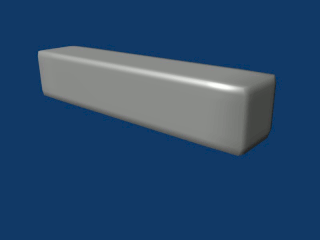
In physics and mechanics, torque is the rotational analogue of linear force. It is also referred to as the moment of force. The symbol for torque is typically , the lowercase Greek letter tau. When being referred to as moment of force, it is commonly denoted by M. Just as a linear force is a push or a pull applied to a body, a torque can be thought of as a twist applied to an object with respect to a chosen point; for example, driving a screw uses torque, which is applied by the screwdriver rotating around its axis. A force of three newtons applied two metres from the fulcrum, for example, exerts the same torque as a force of one newton applied six metres from the fulcrum.

The Lamborghini V10 is a ninety degree (90°) V10 petrol engine which was developed for the Lamborghini Gallardo automobile, first sold in 2003.

The Audi S4 is the high performance variant of Audi's compact executive car A4. The original Audi S4, built from 1991 until 1994, was a performance-oriented version of Audi's 100 saloon/sedan. All subsequent S4s since 1997 have been based on the Audi A4; and as the A4 has evolved from one generation to the next, so has the S4.

Multitronic is a stepless transmission launched by AUDI AG in late 1999, jointly developed and manufactured by LuK. The capitalization used is multitronic and is a registered trademark of AUDI AG.

In the field of solid mechanics, torsion is the twisting of an object due to an applied torque. Torsion is expressed in either the pascal (Pa), an SI unit for newtons per square metre, or in pounds per square inch (psi) while torque is expressed in newton metres (N·m) or foot-pound force (ft·lbf). In sections perpendicular to the torque axis, the resultant shear stress in this section is perpendicular to the radius.
The ZF S6-650 is a 6-speed manual transmission manufactured by ZF Friedrichshafen AG. It is designed for longitudinal engine applications, and is rated to handle up to 705 newton-metres (520 lbf⋅ft) of torque.
The GM–Ford 6-speed automatic transmission is an automatic transaxle originally designed for transverse engine applications in cars. With design work having begun in 2002, General Motors and Ford Motor Company jointly committed to investing US$720 million in their manufacturing plants to support the new transmission.

The Volkswagen Taro 1 tonne pickup truck was introduced in January 1989 by Volkswagen Commercial Vehicles to complement the half tonne Caddy pickup / panel van ranges, and the 1 tonne Transporter van and chassis cab ranges. The name "tarō" is a suffix used in Japanese to denote the oldest brother or son, or the first-born son of a family.

The Volkswagen Constellation is the flagship truck produced by the Brazilian manufacturer Volkswagen Truck & Bus since 2005. The line covering the 13-57 tonne gross combination mass (GCM) segment. It is produced at Resende in Brazil, and is primarily for the South American market.
The Getrag F28/6 manual transmission was built by Getrag and fitted to the C20LET 2.0L Turbo Opel Calibra.
Audi Sport GmbH, formerly known as quattro GmbH, is the high-performance car manufacturing subsidiary of Audi, itself a subsidiary of the greater Volkswagen Group.

The MAN SL202 is a single-decker bus manufactured by MAN in Salzgitter, Germany between 1983 and 1993. It was also available as a chassis for external bodywork.
The ZF Ecomat automotive transmission was specifically designed by ZF Friedrichshafen AG primarily for city-buses and motorcoaches. It has several generations – all of the automatic transmission type, and many variants. The latest variants use a lock-up torque converter along with a retarder. Some variants are listed below.

EcoBoost is a series of turbocharged, direct-injection gasoline engines produced by Ford and originally co-developed by FEV Inc.. EcoBoost engines are designed to deliver power and torque consistent with those of larger-displacement naturally aspirated engines, while achieving up to 20% better fuel efficiency and 15% fewer greenhouse emissions, according to Ford. The manufacturer sees the EcoBoost technology as less costly and more versatile than further developing or expanding the use of hybrid and diesel engine technologies. EcoBoost engines are broadly available across the Ford vehicle lineup.

The Toyota NR engine family is a series of small inline-four piston engines designed and manufactured by Toyota, with capacities between 1.2 and 1.5 litres.

The Ford Focus (third generation), also known as the Focus Mk III, (Code name: C346) debuted at the 2010 North American International Auto Show as a 2012 model. The cars shown were a 4-door sedan and 5-door hatchback, also debuting a new 2.0-litre direct injection I4 engine. A 5-door estate (wagon) was previewed at the Geneva Motor Show a month later.

A dual-clutch transmission (DCT) is a type of multi-speed vehicle transmission system, that uses two separate clutches for odd and even gear sets. The design is often similar to two separate manual transmissions with their respective clutches contained within one housing, and working as one unit. In car and truck applications, the DCT functions as an automatic transmission, requiring no driver input to change gears.
The ZF S6-53 is a 6-speed manual transmission manufactured by ZF Friedrichshafen AG. It is designed for longitudinal engine applications, and is rated to handle up to 600 newton-metres (443 lbf⋅ft) of torque.
The Mathis Vega 42 was a 42-cylinder 6-bank in-line radial piston engine, designed and built in France, by Société Mathis Aviation in the late 1930s, with development continuing during and after WWII.











